sensor HONDA RIDGELINE 2012 1.G Owners Manual
[x] Cancel search | Manufacturer: HONDA, Model Year: 2012, Model line: RIDGELINE, Model: HONDA RIDGELINE 2012 1.GPages: 429, PDF Size: 7.72 MB
Page 30 of 429
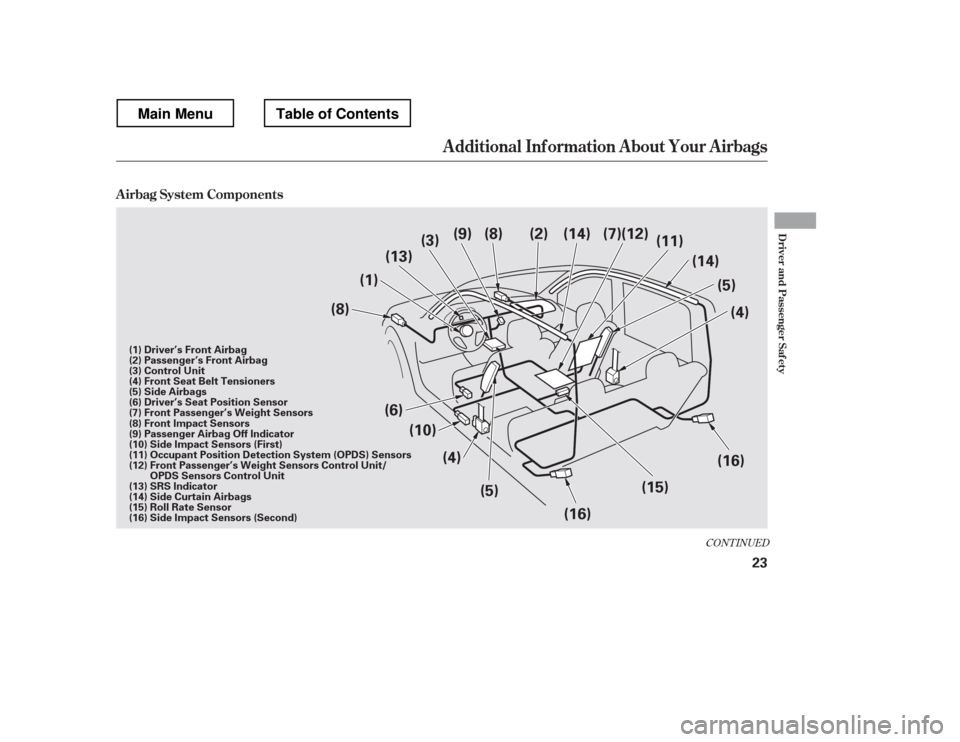
CONT INUED
A irbag System Components
Additional Inf ormation About Your Airbags
Driver and Passenger Saf ety
23
(1)(3)
(5)
(4) (5)
(6)
(10)
(13)
(9) (8) (2)
(16)(4)
(15)
(16)
(8)
(14) (7)(12)
(14)
(11)
(1) Driver’s Front Airbag
(2) Passenger’s Front Airbag
(3) Control Unit
(4) Front Seat Belt Tensioners
(5) Side Airbags
(6) Driver’s Seat Position Sensor
(7) Front Passenger’s Weight Sensors
(12) Front Passenger’s Weight Sensors Control Unit/
OPDS Sensors Control Unit
(13) SRS Indicator
(14) Side Curtain Airbags
(15) Roll Rate Sensor
(16) Side Impact Sensors (Second)
(8) Front Impact Sensors
(9) Passenger Airbag Off Indicator
(10) Side Impact Sensors (First)
(11) Occupant Position Detection System (OPDS) Sensors
Table of ContentsMain Menu
Page 31 of 429
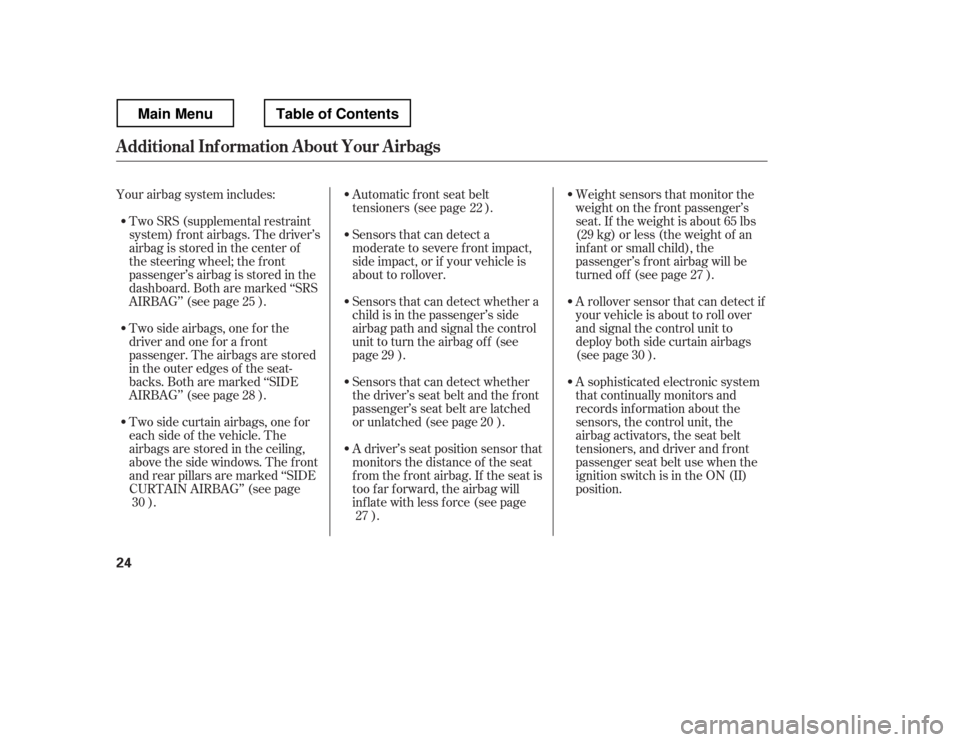
Weight sensors that monitor the
weight on the f ront passenger
Page 37 of 429
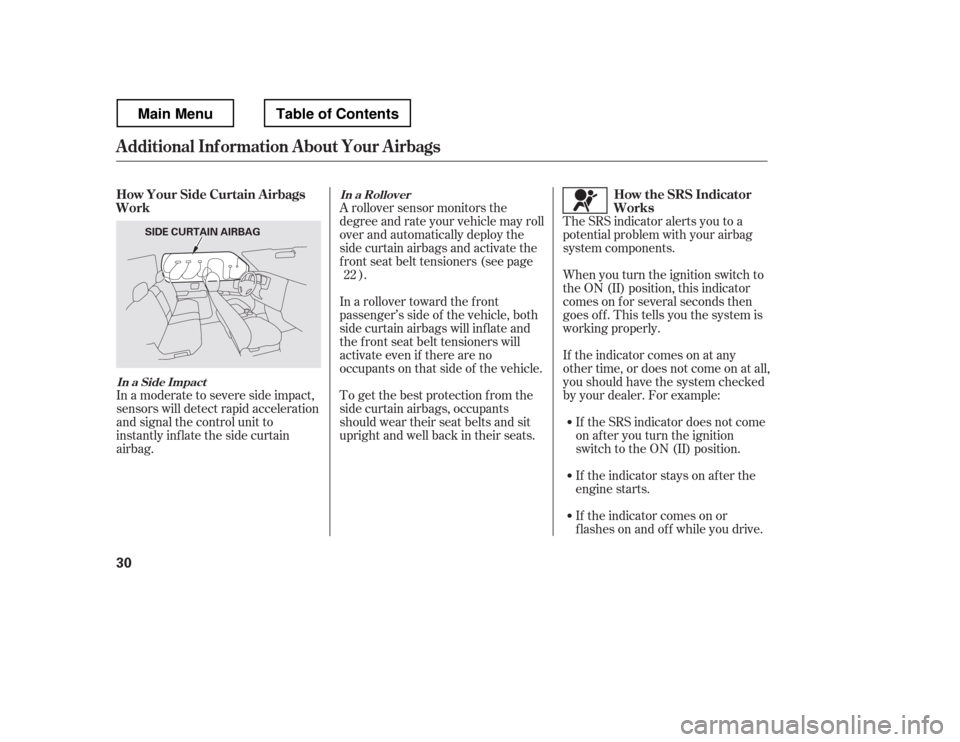
A rollover sensor monitors the
degree and rate your vehicle may roll
over and automatically deploy the
side curtain airbags and activate the
f ront seat belt tensioners (see page).
In a rollover toward the f ront
passenger
Page 39 of 429
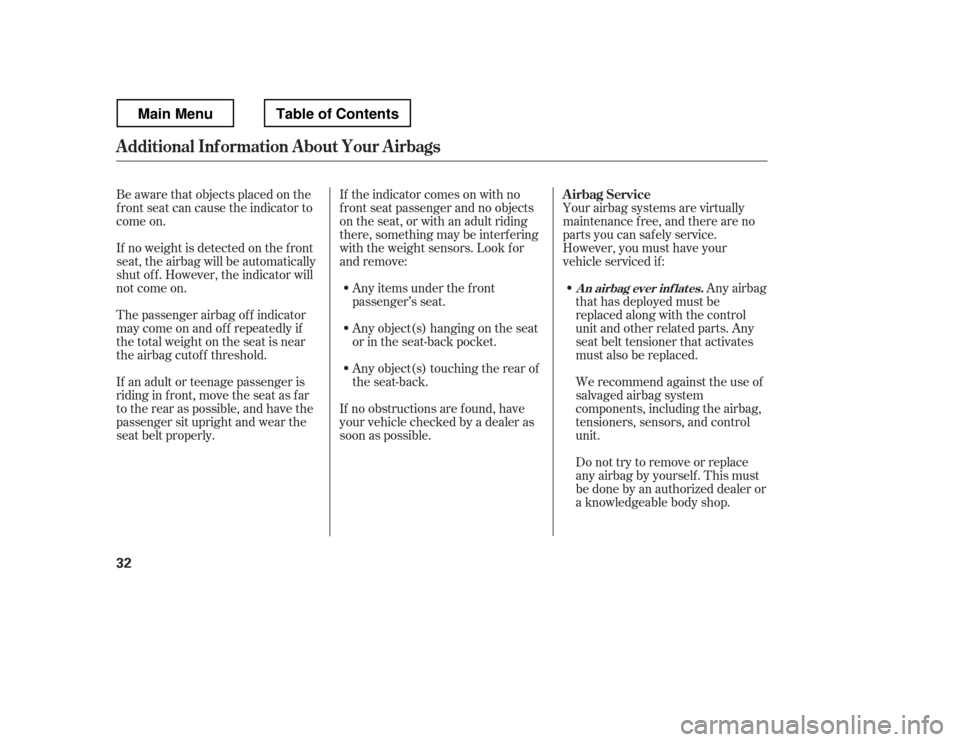
Your airbag systems are virtually
maintenance f ree, and there are no
parts you can saf ely service.
However, you must have your
vehicle serviced if:Any airbag
that has deployed must be
replaced along with the control
unit and other related parts. Any
seat belt tensioner that activates
must also be replaced.
Be aware that objects placed on the
f ront seat can cause the indicator to
come on.
If no weight is detected on the f ront
seat, the airbag will be automatically
shut of f . However, the indicator will
not come on.
The passenger airbag of f indicator
maycomeonandoff repeatedlyif
the total weight on the seat is near
the airbag cutof f threshold.
If an adult or teenage passenger is
riding in f ront, move the seat as f ar
to the rear as possible, and have the
passenger sit upright and wear the
seat belt properly. If the indicator comes on with no
f ront seat passenger and no objects
on the seat, or with an adult riding
there, something may be interf ering
with the weight sensors. Look f or
and remove:
Any items under the f ront
passenger
Page 133 of 429
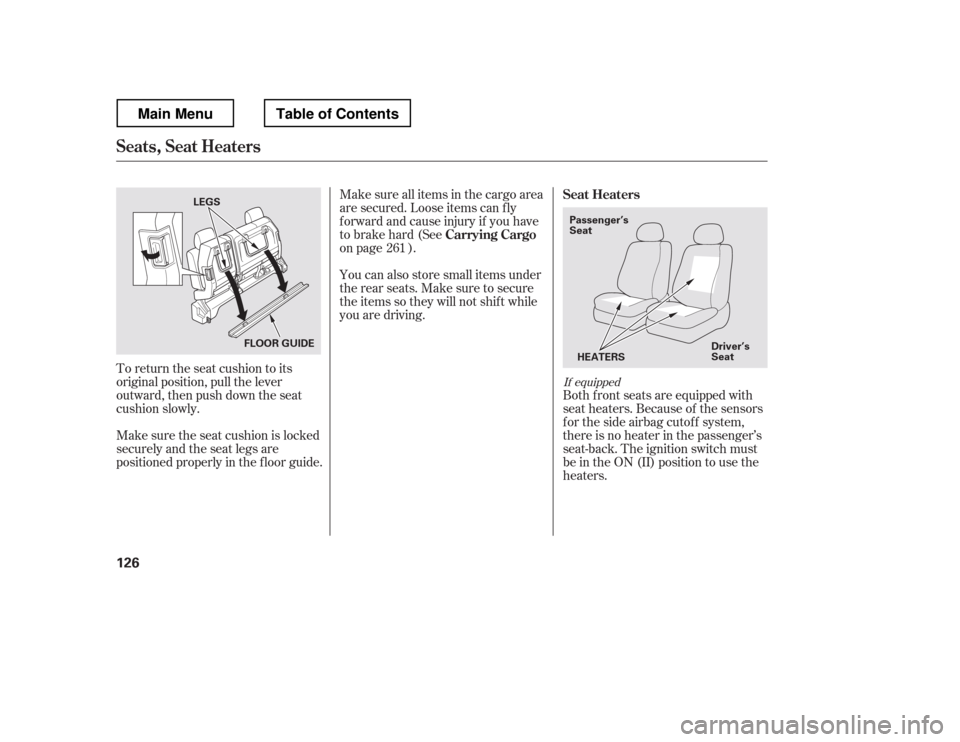
If equipped
Make sure all items in the cargo area
are secured. Loose items can f ly
f orward and cause injury if you have
to brake hard (See
on page ).
You can also store small items under
the rear seats. Make sure to secure
the items so they will not shift while
you are driving.
To return the seat cushion to its
original position, pull the lever
outward, then push down the seat
cushion slowly.
Make sure the seat cushion is locked
securely and the seat legs are
positioned properly in the f loor guide. Both f ront seats are equipped with
seat heaters. Because of the sensors
f or the side airbag cutof f system,
there is no heater in the passenger
Page 148 of 429
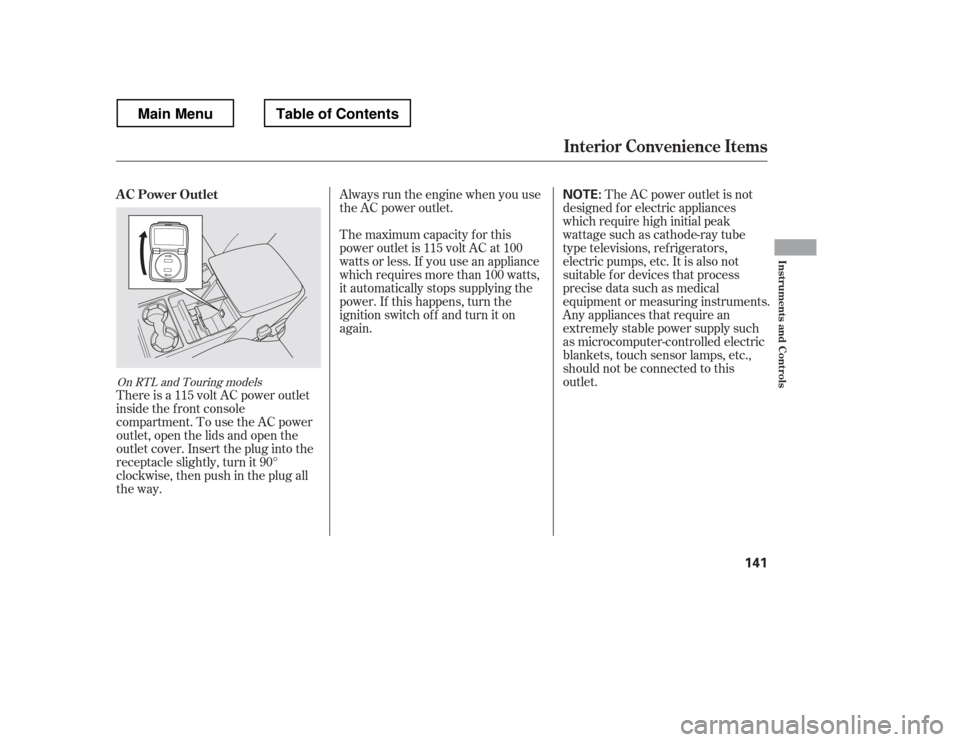
Always run the engine when you use
the AC power outlet.
The maximum capacity f or this
power outlet is 115 volt AC at 100
watts or less. If you use an appliance
which requires more than 100 watts,
it automatically stops supplying the
power. If this happens, turn the
ignition switch of f and turn it on
again.The AC power outlet is not
designed f or electric appliances
which require high initial peak
wattage such as cathode-ray tube
type televisions, ref rigerators,
electric pumps, etc. It is also not
suitable f or devices that process
precise data such as medical
equipment or measuring instruments.
Any appliances that require an
extremely stable power supply such
as microcomputer-controlled electric
blankets, touch sensor lamps, etc.,
should not be connected to this
outlet.
There is a 115 volt AC power outlet
inside the f ront console
compartment. To use the AC power
outlet, open the lids and open the
outlet cover. Insert the plug into the
receptacle slightly, turn it 90
Page 165 of 429
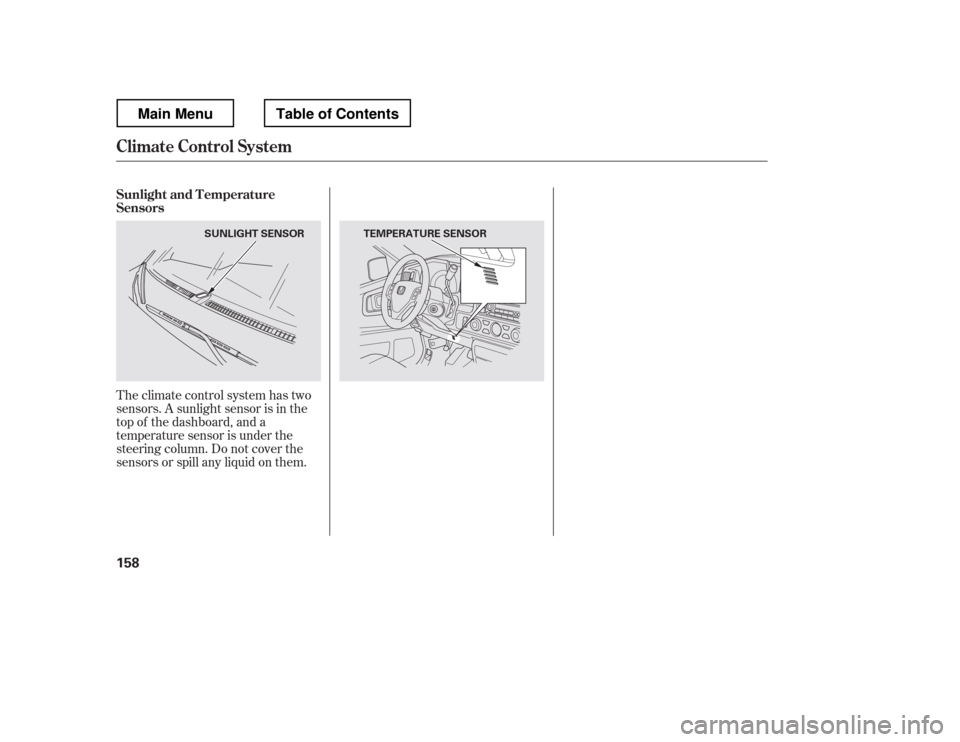
Theclimatecontrolsystemhastwo
sensors. A sunlight sensor is in the
top of the dashboard, and a
temperature sensor is under the
steering column. Do not cover the
sensors or spill any liquid on them.
Sunlight and T emperature
Sensors
Climate Control System
158
SUNLIGHT SENSOR TEMPERATURE SENSOR
Main MenuTable of Contents
Page 221 of 429

Drive the vehicle slowly in circles
at less than 5 mph (8 km/h) until
the center icon turns blue. This
icon also turns blue by continuing
to drive the vehicle under normal
driving conditions. When you see
an actual heading on the compass,
calibration is completed.
The compass may need to be
manually calibrated af ter exposure to
a strong magnetic field. If the
compassseemstocontinuallyshow
the wrong direction, do this.
Do this procedure in an open
area, away f rom buildings, power
lines, and other vehicles.
With the blue center icon
displayed,pressandholdthe
compass button for about 6
seconds. When the center icon
turns red, release the button.
The compass mirror has a light
sensor behind the right side of the
rearview mirror. Make sure the
extended sun visor or an accessory is
not covering the sensor.
2.
1.
Compass
Compass Calibration
214
NOTE:
Main MenuTable of Contents
Page 271 of 429
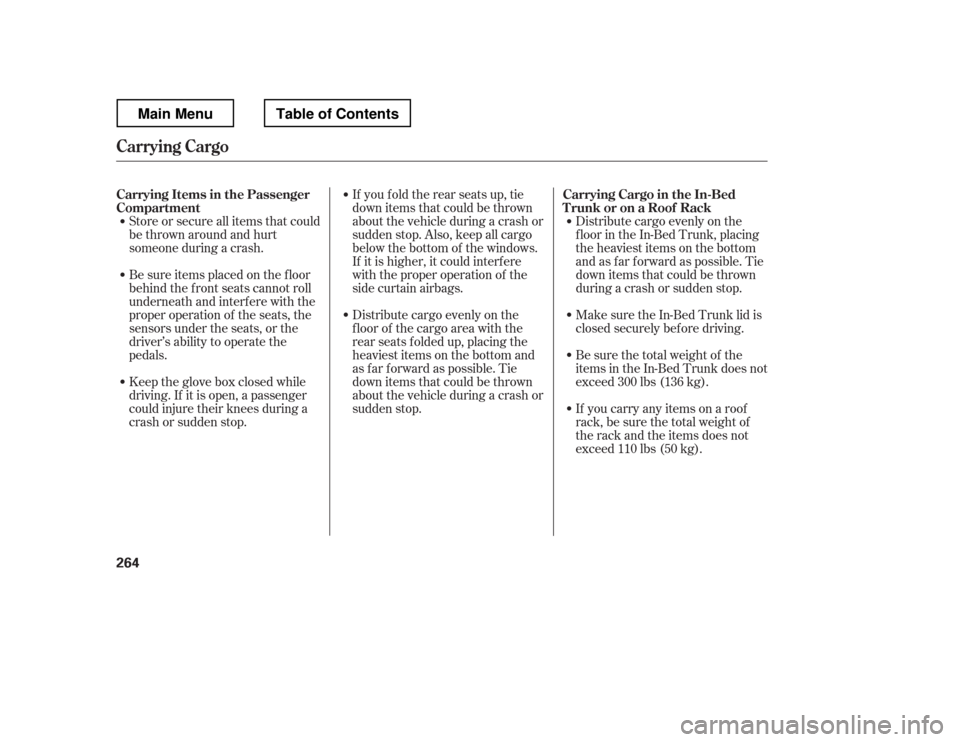
Store or secure all items that could
be thrown around and hurt
someone during a crash.Distribute cargo evenly on the
f loor in the In-Bed Trunk, placing
the heaviest items on the bottom
and as far forward as possible. Tie
down items that could be thrown
during a crash or sudden stop.
Make sure the In-Bed Trunk lid is
closed securely bef ore driving.
Be sure the total weight of the
items in the In-Bed Trunk does not
exceed 300 lbs (136 kg).
Be sure items placed on the f loor
behind the f ront seats cannot roll
underneath and interf ere with the
proper operation of the seats, the
sensors under the seats, or the
driver
Page 292 of 429
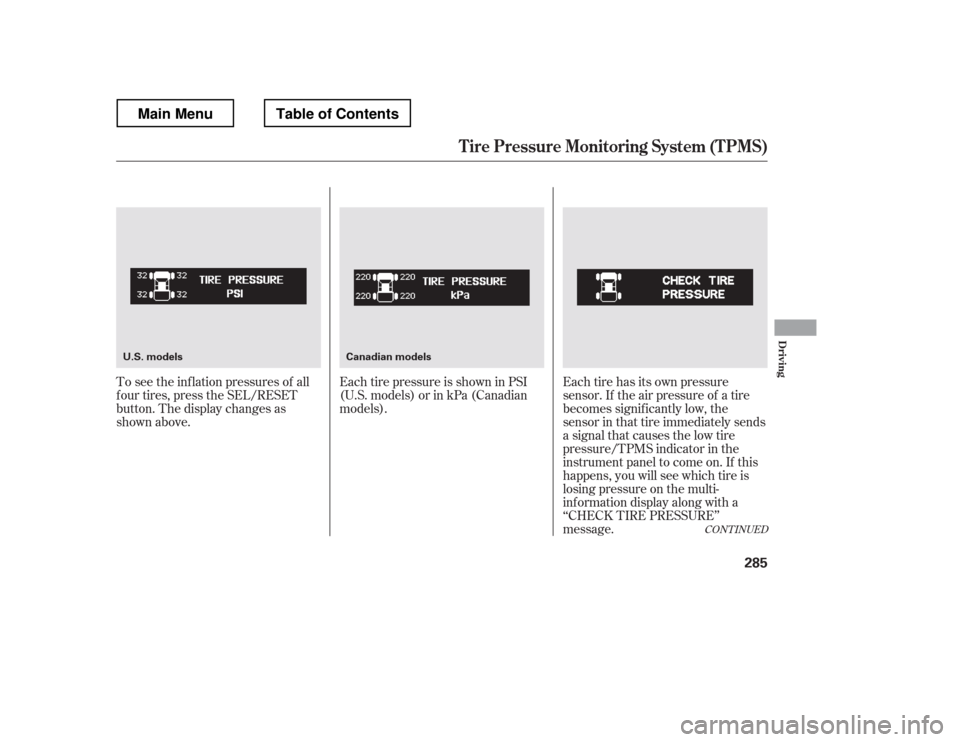
CONT INUED
To see the inf lation pressures of all
f our tires, press the SEL/RESET
button. The display changes as
shown above.Each tire pressure is shown in PSI
(U.S. models) or in kPa (Canadian
models).
Each tire has its own pressure
sensor. If the air pressure of a tire
becomes signif icantly low, the
sensor in that tire immediately sends
a signal that causes the low tire
pressure/TPMS indicator in the
instrument panel to come on. If this
happens, you will see which tire is
losing pressure on the multi-
inf ormation display along with a
‘‘CHECK TIRE PRESSURE